BENEFITS FROM VOLCANOES
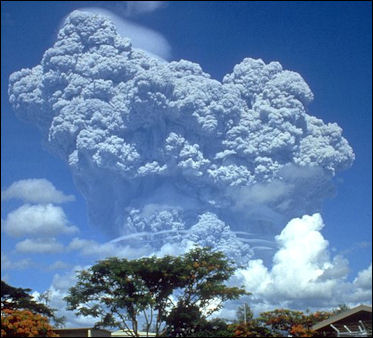
Pinatubo eruption Volcanoes destroy and volcanoes create. The catastrophic eruption of Mount St. Helens on May 18, 1980, made clear the awesome destructive power of a volcano. Yet, over a time span longer than human memory and record, volcanoes have played a key role in forming and modifying the planet upon which we live. More than 80 percent of the Earth's surface--above and below sea level--is of volcanic origin. Gaseous emissions from volcanic vents over hundreds of millions of years formed the Earth's earliest oceans and atmosphere, which supplied the ingredients vital to evolve and sustain life. Over geologic eons, countless volcanic eruptions have produced mountains, plateaus, and plains, which subsequent erosion and weathering have sculpted into majestic landscapes and formed fertile soils. [Source: Robert I. Tilling, USGS]
Volcanic materials ultimately break down to form some of the most fertile soils on Earth, cultivation of which fostered and sustained civilizations. People use volcanic products as construction materials, as abrasive and cleaning agents, and as raw materials for many chemical and industrial uses. The internal heat associated with some young volcanic systems has been harnessed to produce geothermal energy. For example, the electrical energy generated from The Geysers geothermal field in northern California can meet the present power consumption of the city of San Francisco.
Volcanic soils and inviting terranes have attracted, and continue to attract, people to live on the flanks of volcanoes. Thus, as population density increases in regions of active or potentially active volcanoes, mankind must become increasingly aware of the hazards and learn not to "crowd" the volcanoes. People living in the shadow of volcanoes must live in harmony with them and expect, and should plan for, periodic violent unleashings of their pent-up energy.
See Separate Articles PLATE TECTONICS factsanddetails.com ; VOLCANO COMPONENTS, STRUCTURE AND ACTIVITY factsanddetails.com ; TYPES OF VOLCANOES factsanddetails.com ; VOLCANIC ERUPTIONS: TYPES, PHASES AND CAUSES factsanddetails.com ; DESTRUCTIVE ERUPTIONS: LAHARS, PYROCLASTIC FLOWS AND GLACIAL BURSTS factsanddetails.com ; MAJOR VOLCANIC ERUPTIONS: LAKI, EL CHICHON AND THE ONE IN A MEXICAN CORNFIELD factsanddetails.com ; POMPEII AND HERCULANEUM AND ERUPTIONS OF VESUVIUS factsanddetails.com ; VOLCANO RESEARCH, STUDY, MONITORING AND PREPAREDNESS factsanddetails.com
Websites and Sources on Volcanoes: USGS Volcanoes volcanoes.usgs.gov ; Volcano World volcano.oregonstate.edu ; Volcanoes.com volcanoes.com ; Wikipedia Volcano article Wikipedia , Smithsonian Global Volcanism Program volcano.si.edu operated by the Smithsonian has descriptions of volcanoes around the globe and a catalog of over 8,000 eruptions in the last 10,000 years.;
Global Consequence of Volcanic Eruptions

Eyjafjallajokull As the 2010 eruption of the Eyjafjallajokull volcano in Iceland showed a volcanic eruption can have global consequences. In what turned out to be the worst global travel disruption since World War II over 100,000 flights scheduled to take off or land in Europe were canceled, hundreds of thousands of passengers were stranded and a third of the global travel industry was shut down. The airline industry lost over $2 billion and single airlines lost $30 million a day and single travel operators lost $9 million a day as they scrambled to get people home and put them up in the places they were stranded.
Not only that salmon farms reduced harvests because of a lack of transportation to move fish, auto factories in China stopped operating because they were unable to get parts from Germany, day laborers in Kenya lost their jobs, and million of flowers rotted because the flowers could not be transported to Europe. Clinics in New Zealand postponed seasonal flu shots because were unable to get vaccines made in France and fresh fruit processing centers in Brazil shut down because they were unable to export fruit to Europe. German Chancellor Angela Merkel who was returning from San Francisco was forced to fly first to North Dakota them Lisbon and Rome before making her way back to Germany by car and bus.
The Eyjafjallajokull eruption relatively was a medium-size eruption. Material was only ejected about 7,500 meters into the atmosphere. Bigger eruption thrust material to over 10,000 meters, where it can affect the global climate. If Eyjafjallajokul’s large neighbor Katna erupted, as it often has after Eyjafjallajokull erupts, the consequences could be much more severe.
It s still not clear how much volcanic material is necessary to damage airplane engines. When the Eyjafjallajokull eruption occurred there were no clear standards. In the middle of the eruption crisis the figure of 2,000 micrograms or dust or ash per cubic meter, a figure that came from engine manufacturers, was given. On top of that scientist have difficult measuring and predicting ash concentration in different areas and different elevations.
Marrianne Guffanti, a geologist with USGS, told the Washington Post, “ Volcanic risk is actually rising...because people are putting themselves nearer volcanoes, particularly with air travel.” One of the reasons the consequence of volcanic eruptions is less than what they might be is that for most people insurance is not available for volcanic eruption.
Glaciers, Climate and Volcanoes
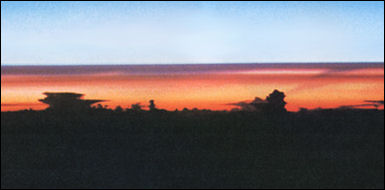
Pinatubo dust layer Among the more prominent theories of events that have triggered global climatic changes and lead to repeated glaciation are: (1) known astronomical variations in the orbital elements of the Earth (the so-called Milankovitch theory); (2) changes in energy output from the Sun; and (3) increases in volcanism that could have thrown more airborne volcanic material into the stratosphere, thereby creating a dust veil and lowered temperatures.
The years 1980, 1981, and 1982, for example, saw several major volcanic eruptions adding large quantities of particulate volcanic material and volatiles to the stratosphere, including the catastrophic eruption of Mount St. Helens, Washington, on May 18, 1980, and a large eruption of Mount Hekla, Iceland, on August 17, 1980. The 1982 series of eruptions from El Chichón volcano, Mexico, caused death and destruction in the populated area around the volcano, but a further reaching impact may result from the effect on Earth's climate because of the enormous ejection of volcanic material into the stratosphere.
The potential climatic effect of the Laki volcanic eruption in Iceland in 1783, the largest effusive (lava) volcanic eruption in historic time, was noted by the diplomat-scientist Benjamin Franklin in 1784, during one of his many sojourns in Paris. Franklin concluded that the introduction of large quantities of volcanic particles into the Earth's upper atmosphere could cause a reduction in surface temperature, because the particles would lessen the amount of solar energy reaching the Earth's surface. The catastrophic eruption of the Tambora volcano, Indonesia, in 1815 was followed by a so-called "year-without-a-summer." In New England, for example, frost occurred during each of the summer months in 1816.
Pinatubo’s Sulfuric Acid Cloud and Effects of the Tamboro Eruption
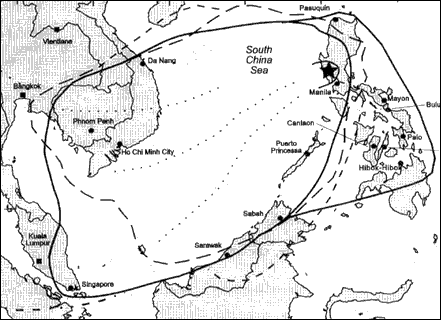
Tephra fall from 1991 eruption of Mt Pinatubo During the Mt Pinatubo eruption in 1991 material was hurled 40 kilometers (25 miles) above the ground into the stratosphere. Layers of dust settles at around 100,000 feet and took years to dissipate. Around 20 million tons of sulfur dioxide made its way to the stratosphere, where it combined with moisture creating a thin aerosol cloud of sulfuric acid that girdled the globe within 21 days.
The layer of sulfate aerosol scattered light sunlight and absorbed heat from the earth, cooling the planet's surface. Pinatubo caused world temperature to drop about a half a degree. Scientists, measuring the depth of the cloud by satellite observation, calculate that 2 percent of the incoming sunlight was deflected from the earth by the layer of sulfate aerosol.
The deadliest volcanic eruption in the last 10,000 years occurred on Tambora on Sumbawa in Indonesia. It killed 92,000 people in April 1815. Twelve thousand died in the blast; the remainder died in tsunamis or starved to death because their crops and livestock were destroyed, mostly on Sumbawa and Lombok. [Source: Robert Evans, Smithsonian Magazine, July 2002]
Tamboro’s explosion created the huge quantities of sulfurous gas which mixed with water in the air, producing a cloud of sulferic acid, ash and dust that was blown around the world by stratospheric winds. Ice cores taken from Greenland in 1815 and 1816 show unusually high levels of sulfur, a remnant of the Tamboro explosion.
So much material was in this cloud that it lowered temperatures around the globe and produced blizzards in the Midwest and snowfall in the U.S. east coast and London in August, caused poor harvests in New England and Europe, and killed water buffalo and flooded rice crops in China and Tibet in what became known as the year without summer. One Virginia resident wrote. “In June...another snowfall came and folks went sleighing...On July 4, water froze in cisterns and snow fell again, with Independence Day celebrants moving inside churches where hearth fires warmed things a mite.”
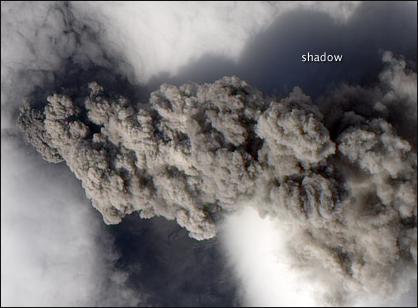
Eruption of Eyjafjallajökull in Iceland in 2011.Among other things the volcano is believed to have produced the appalling weather that distrupted Napoleon at Waterloo and caused crop failures and famines that lead to social unrest throughout Europe. The gloomy weather inspired Byron’s poem “Darkness” and is believed to have had a hand in creating the characters Dr. Frankenstein and the monster by Bryon’s friend Mary Shelley.
Volcanic Ash and Planes
It is very dangerous to fly a plane through a volcanic cloud. Heavy ash can sandblast windows, making them impossible to see through. What is most dangerous is when ash is sucked into an engine. When it enters the hot combustion chamber it melts into molten glass, clogging the machinery, degrading the fan blades, and potentially causing the engine to flameout.
That is what happened in 1982 to a British Airways flight that ran into an undetected volcanic ash cloud off Indonesia. It lost all four of its engines but was able to restart some of them and make an emergency landing.
In 2000, a NASA research plane went through a high altitude volcanic ash cloud without the pilot realizing it. The plane landed without incident but when scientists took apart the engines they discovered $32.2 million worth of damage than could have easily brought the plane down.
It is possible to fly around ash clouds or above and below them, but it is difficult to accurately measure the boundaries of different ash clouds densities and determine ash concentration in particular locations. Disruptions caused by the 2010 eruption of the Eyjafjallajokull volcano in Iceland lead scientist to give serious study to how much ash in the air was necessary to halt air travel.
Volcano Environments
Most active volcanoes are strung like beads along, or near, the margins of the continents, and more than half en circle the Pacific Ocean as a "Ring of Fire." Many volcanoes are in and around the Mediterranean Sea. Mount Etna in Sicily is the largest and highest of these mountains. Italy's Vesuvius is the only active volcano on the European mainland. Near the island of Vulcano, the volcano Stromboli has been in a state of nearly continuous, mild eruption since early Roman times. At night, sailors in the Mediterranean can see the glow from the fiery molten material that is hurled into the air. Very appropriately, Stromboli has been called "the lighthouse of the Mediterranean.
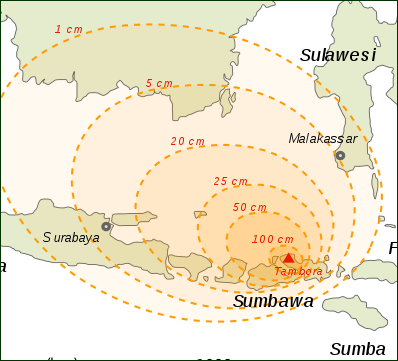
Tambora ashfall in 1815Some volcanoes crown island areas lying near the continents, and others form chains of islands in the deep ocean basins. Volcanoes tend to cluster along narrow mountainous belts where folding and fracturing of the rocks provide channelways to the surface for the escape of magma. Significantly, major earthquakes also occur along these belts, indicating that volcanism and seismic activity are often closely related, responding to the same dynamic Earth forces.
In a typical "island-arc" environment, volcanoes lie along the crest of an arcuate, crustal ridge bounded on its convex side by a deep oceanic trench. The granite or granitelike layer of the continental crust extends beneath the ridge to the vicinity of the trench. Basaltic magmas, generated in the mantle beneath the ridge, rise along fractures through the granitic layer. These magmas commonly will be modified or changed in composition during passage through the granitic layer and erupt on the surface to form volcanoes built largely of nonbasaltic rocks.
In a typical "oceanic" environment, volcanoes are alined along the crest of a broad ridge that marks an active fracture system in the oceanic crust. Basaltic magmas, generated in the upper mantle beneath the ridge, rise along fractures through the basaltic layer. Because the granitic crustal layer is absent, the magmas are not appreciably modified or changed in composition and they erupt on the surface to form basaltic volcanoes.
In the typical "continental" environment, volcanoes are located unstable, mountainous belts that have thick roots of granite or granitelike rock. Magmas, generated near the base of the mountain root, rise slowly or intermittently along fractures in the crust. During passage through the granitic layer, magmas are commonly modified or changed in composition and erupt on the surface to form volcanoes constructed of nonbasaltic rocks.
Benefits of Volcanic Soils
Why are volcanic soils fertile? Volcanic materials make soil fertile when they have had the chance to weather and start to break down and release their nutrients. Apart from water and carbon dioxide, plants need three essential nutrients to grow: nitrogen, potassium and phosphorous. They also need some iron to create chlorophyll, which primary function is to absorb sunlight for photosynthesis to occur within the plant. A process which is possible in the presence of radiant energy (light) where carbon dioxide and water are converted into oxygen and organic materials that can be used within the plant. Volcanic materials can be sources of nitrogen, potassium and phosphorous. Furthermore, volcanic soil can also supply in small quantities a number of trace elements that may be scarce, but are very important and necessary to allow plants to make the right proteins and other molecules necessary for life. [Source: Yahoo Answers]
The fertile soil is a result of the breakdown of various minerals - such as olivine, pyroxene, amphibole, and feldspar (the essential ingredients of volcanic ash and lava) which releases iron, magnesium, potassium and other nutrients into to the soil. Lavas and ash are rich in potassium and iron, which is often a limiting nutrient. Certain types of crystallized lava can be very porous, and vesicular, meaning that they can hold large amounts of water, especially if they've been given time to weather and erode. Certain lavas, dependent on local magma chemistry, can include significant amounts of magnesium, silica, aluminum, sodium, and chlorine.
Volcanic soils often carry many non-crystalline (amorphous) minerals, such as allophone and imogolite, which form strong bonds with organic materials, which, in addition to the elemental chemistry in the volcanic soils, allows enormous amounts of plant life to take root. New lavas aren't very fertile. They need time to weather and release their nutrients, and to open up those pores. This is why in Hawaii Kauai'i (an older island where lava has had time to weather and break down) is the Garden Isle and the Big Island (a younger, volcanically-active island where lava has not had time to weather and break down) has surprisingly few places that are actually lush with vegetation.
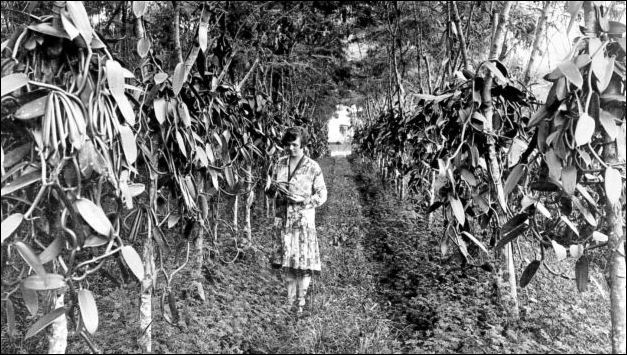
Vanilla growing in the volcanic soils of Java
However, the dispersal of volcanic ash can also be devastating to soil and organics. When Mt. St. Helens went off, its ash covered enormous areas. Its particular ash acted as somewhat of a clay mineral when it gathered, especially when it bonded with precipitation, forming a fairly impermeable layer that hurt not only soils, but also stuck directly to plants themselves, causes physical trauma and chemical trauma as well, blocking out light and gas intake/release for photosynthesis.
Presence of People Is What Makes A Volcano Dangerous
Sarah Zielinski wrote in smithsonian.com:“Most of the world’s volcanoes are located deep beneath the sea surface along the mid-ocean ridges where the Earth’s crust spread and creates new ocean floor. Volcanoes on land often occur in subduction zones, where one tectonic plate is diving beneath another, or hotspots created by mantle plumes deep within the planet. [Source: Sarah Zielinski, smithsonian.com, July 22, 2014]
“Living near an active volcano would not seem to be a smart choice, but many people make their homes in the shadows of these simmering mountains. They might be lured by the high-quality volcanic soil or the potential for geothermal energy. Or a volcano might have been dormant long enough that people began to think it would no longer be active.
“In 79 A.D., Vesuvius erupted, burying the nearby city of Pompeii under four to six meters of ash. At the same time, the wealthier town of Herculaneum was destroyed by volcanic mudslides. Vesuvius has erupted more than 30 times since then, most recently in 1944, when several villages were destroyed. But more worrisome is the Italian city of Naples, which sits near the volcano and is today home to more than a million people within the city limits and another 3 million spreading out into the countryside. A 2006 study published in the Proceedings of the National Academy of Sciences predicted that the city could be destroyed should Vesuvius explode in a manner similar to its worst eruption, which occurred nearly 4000 years ago.
“Residents of Seattle may have thought they had little to worry about when it came to Mount Rainier, the snow-covered volcanic mountain sitting a short drive from the city. After all, the volcano last erupted in 1894. But a study published in the July 17 Nature is a reminder that the volcano is still active: The study didn’t put an estimated on the timing of the next eruption, but researchers were able to map the conduits and magma chambers that feed Rainer’s magma, capturing a picture of melting right at the subducting slab beneath the slumbering giant.
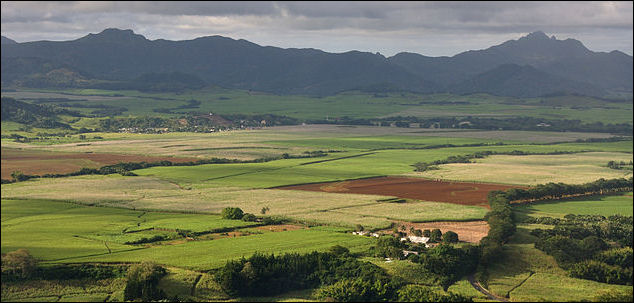
sugar growing in the volcanic soils of Mauritius
“The mountain’s dangers extend beyond the ash, pumice and lava people most associated with volcanoes. This volcano is also known for steam eruptions and mudflows—mixtures of volcanic debris and water as heat from the volcano melts ice on the mountain. An eruption 5600 years ago spawned a mudflow that covered a huge section of land that today is home to the city of Tacoma, a couple of Seattle suburbs and several nearby towns.
Image Sources: Wikimedia Commons, United States Geological Survey (USGS); Volcano Research Center University of Tokyo (the Japan pictures); San Diego State University, U.S. Geological Survey (non-Japan pictures)
Text Sources: United States Geological Survey (USGS), New York Times, Washington Post, Los Angeles Times, Times of London, Yomiuri Shimbun, The Guardian, National Geographic, The New Yorker, Time, Newsweek, Reuters, AP, Lonely Planet Guides, Compton’s Encyclopedia and various books and other publications.
Last updated April 2022
